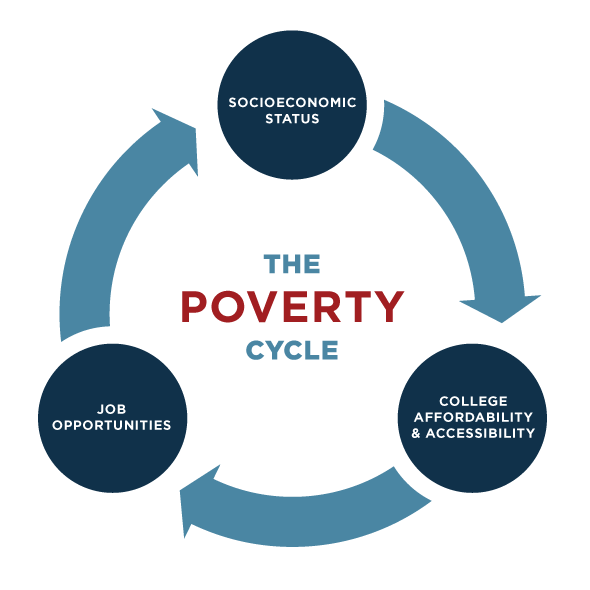Anyone with even a passing interest in discussions of poverty has heard of the poverty cycle. The poverty cycle explains why poor kids wind up poor as adults by demonstrating that the conditions that correspond with growing up poor set the stage for future poverty. In what seems to be its most popular form, the poverty cycle looks like this:

I pulled this image from the Student Labor Action Project, an interesting organization when organizing student solidarity around labor battles, a slightly less interesting organization when commenting on poverty policy. Like many commentators on the poverty cycle, the paragraph that goes along with this image focuses heavily on the “College Affordability & Accessibility” step. If we can make college more affordable and accessible, that will lead to better job opportunities, and then less poverty.
On this blog, I have written extensively about the monumental failures involved in this kind of thinking. Focusing on college misses the point that by the time college rolls around, poor people are already very far behind (I, II). Making college more affordable and accessible will not do very much for people whose poverty have left them unable to actually complete college-level work.
More fundamentally, this kind of thinking misses the fact that college attainment leads to more job opportunities for those who achieve it because college attainment provides positional advantages in the labor market. Those with college degrees have the best chance at capturing the scarce number of non-poverty economic positions. What matters is the total number of non-poverty economic positions, not the total number of college graduates. If you do not make more non-poverty economic positions for people to inhabit, then putting more people through college can only change the composition of who winds up in poverty, not the number of people who do so.
To be sure, increasing overall education can make workers in general more productive, which can in turn increase overall GDP. This is the basic neoliberal human capital picture of why education makes things better. Importantly however, making workers more productive through increasing overall educational attainment says nothing about how the gains from that increased productivity are actually distributed. We have seen huge productivity gains in the US over the last 4 decades, the benefits from which have almost all flowed to the very top of the income distribution.
These are critiques I have made over and over; so regular readers are probably bored by now. But I actually want to point out something new here. Put aside these points about why the education focus is the wrong one and just look at the poverty cycle graphic. There are three circles, and if we disrupt any one of them, the cycle is supposed to break. The graphic effectively claims that poverty leads to not being able to go to college, which leads to not getting good jobs, which leads back to poverty. Everyone always focuses on the “not being able to go to college” part. But why? There are two other options on the board.
Of those two options — creating good job opportunities and improving socioeconomic status of the poor — the latter option is far and away the easiest one to pull off. Just give poor people enough money so that they are not poor anymore. You might think this would be costly, but you would be wrong. The venerable Doug Henwood crunched the numbers in LBO 134, published in February of this year:
How much would it take to bring all the officially poor up to the poverty line? Surprisingly little: about 1% of GDP, or not quite 10% of the Census Bureau’s estimate of the income of the richest 5%. It’s about half the increase in the military budget since 2000.
When people look at these poverty cycle graphics, the focus is always on not letting the arrows make their way back to the initial poverty starting point. But they always leave out the most obvious solution: just tackle the initial poverty starting point. If you end poverty by making people not poor, the logic of the graphic clearly demonstrates that the arrow will not make its way back around to poverty again. I think we should give that a try.